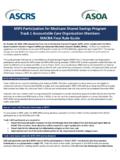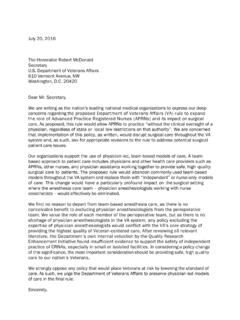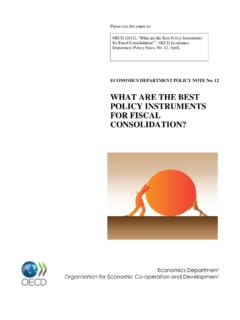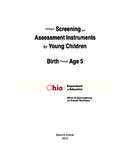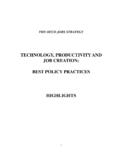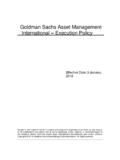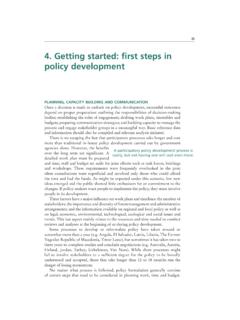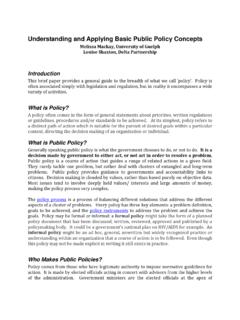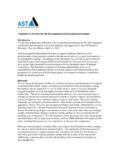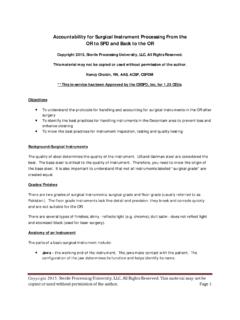Transcription of Guidelines for the Cleaning and Sterilization of ...
1 Guidelines for the Cleaning and Sterilization of Intraocular Surgical instruments Ophthalmic Instrument Cleaning and Sterilization (OICS) Task Force Co-chairs: David F. Chang, MD, Nick Mamalis, MD OICS Task Force Members: American Society of Cataract and Refractive Surgery (ASCRS): Robert J. Cionni, MD, Richard S. Hoffman, MD, Francis S. Mah, MD, Neal H. Shorstein MD, Nancey K. McCann, Director of Government Relations, Joyce J. D Andrea, COMT, Director of Allied Health Education American Academy of Ophthalmology (AAO): Michael X. Repka, MD, MBA, Flora Lum, MD, Vice President, Quality and Science Division Ophthalmic Outpatient Surgery Society (OOSS): Jeffrey Whitman, MD, Michael A. Romansky, JD, Washington Counsel, Nikki Hurley, RN, MBA, COE These Guidelines are intended to assist ambulatory surgery centers (ASCs) in their efforts to adopt appropriate practices for the Cleaning and Sterilization of intraocular surgical instruments .
2 They are provided for scientific, educational, and informational purposes only. They are not intended to establish the only acceptable or appropriate standards, methods, or practices for Cleaning and sterilizing such instruments . Adherence to these Guidelines does not guarantee compliance with any legal or regulatory standards, including without limitation the criteria for ASC licensure or certification, or Medicare or other third-party payer reimbursement. In addition, any discussion or recommendation in these Guidelines regarding the use of drugs or devices that deviate from the Food and Drug Administration (FDA) approved use of such product (ie, an off-label use ) is made for scientific and educational purposes only and intended to fall within the FDA s practice of medicine exception for off-label uses.
3 Individual physicians must make independent judgments as to whether the off-label use of a particular drug or device is appropriate and in the patient s best interest based on the facts and circumstances of the particular case. Introduction Postoperative infectious endophthalmitis and toxic anterior segment syndrome (TASS) are rare, but potentially sight-threatening complications of cataract and other intraocular surgery. The small volume of the eye and its sensitivity to minute amounts of chemical or microbial contaminants means that improper instrument Cleaning or Sterilization practices might pose a significant risk to patients. The Ophthalmic Instrument Cleaning and Sterilization (OICS) Task Force is made up of representatives of the American Society of Cataract and Refractive Surgery (ASCRS), the American Academy of Ophthalmology (AAO), and the Outpatient Ophthalmic Surgery Society (OOSS).
4 These professional societies represent ophthalmologists and the clinical staff of ophthalmic outpatient surgery centers, including surgeons, nurses, and technicians. The OICS Task Force includes experts on TASS and endophthalmitis and has written this document to provide specialty-specific, evidence-based Guidelines for the Cleaning and Sterilization of intraocular surgical instruments . This document is an update of original recommended practices for Cleaning and sterilizing intraocular surgical instruments published in Most of the recommended practices are derived from existing evidence-based recommendations for Cleaning and sterilizing all surgical instruments in general,2 4 from published analyses of TASS outbreaks,5 12 and from manufacturers instructions for use (IFU) for surgical instruments and equipment.
5 In addition, task force members have collaborated in performing new research that supports certain recommendations, which is referenced in this document. This specialty-specific document seeks to outline minimum standards for intraocular instrument Cleaning and Sterilization based on a consensus of experts representing the 3 sponsoring societies. Although developed specifically for cataract surgery, the recommendations in this document are also relevant for instruments used in other intraocular surgical procedures. It is not intended to be a comprehensive list of every requirement for Sterilization and quality assurance of the Sterilization process. Individual centers might elect to incorporate additional measures beyond what is outlined in this document.
6 Appropriate consideration should also be given to Guidelines from other relevant organizations .2 4,13 However, many recommendations from these published Guidelines are made with respect to all surgical procedures and are not specific to ophthalmic instrumentation and surgery. Therefore, those recommendations often do not take into account the unique conditions of intraocular surgery and special requirements for Cleaning and sterilizing ophthalmic instrumentation. As a result, all-inclusive, broad Guidelines attempting to cover surgery from head to toe could sometimes include inappropriate, or even risky, practices for ophthalmic cases. For example, cataract surgeries are shorter than many general surgical procedures and are often performed with higher daily volumes.
7 Intraocular surgical instruments are among the smallest in size and generally do not become heavily soiled from tissue or bacterial contamination. On the other hand, minute amounts of detergent or chemical contaminants that would be well tolerated in other body cavities can cause severe intraocular inflammation (TASS) when introduced into the ,15 These characteristics might differentiate optimum Cleaning and Sterilization procedures for cataract surgery from those required for many other types of surgery. Toxic Anterior Segment Syndrome (TASS) Toxic anterior segment syndrome is an acute severe inflammatory reaction to a toxic contaminant introduced into the anterior chamber during intraocular surgery. In addition to severe anterior chamber cell and flare, it might be associated with fibrin, hypopyon, diffuse limbus-to-limbus corneal edema, atonic pupil, secondary glaucoma, and in some cases, vitreous Because of these signs, TASS might be misdiagnosed and mistreated as infectious endophthalmitis.
8 Even if TASS resolves with treatment and without permanent sequelae, the patient often suffers the emotional trauma of believing he or she might have a potentially blinding infection. A large outbreak of TASS in 2006 led to the formation of the ASCRS TASS Task Force, whose surveys and site visits have consistently shown that improper instrument Cleaning and Sterilization is the most commonly identified cause of , 18 The TASS Task Force separately analyzed and compared causes of TASS during 2 periods: 2007 2009 and 2009 , 18 Data from 130 questionnaires and 71 site visits to affected ambulatory surgery centers (ASCs) were incorporated into the final analysis of 1454 cases of TASS from approximately 69,000 concomitant cataract surgeries.
9 The most common risk factors for TASS included inadequate flushing and rinsing of handpieces, use of enzyme detergents, and use of ultrasonic 2014 Ophthalmic ASC Survey of Sterilization Practice In 2014, a survey developed by the OICS Task Force was sent to OOSS member ASCs regarding Cleaning and Sterilization of intraocular instruments . The survey was completed by 232 respondent centers representing a variety of ambulatory surgical settings including single-specialty ophthalmology and multispecialty centers. Ownership models included 100% physician owned, corporate affiliated, hospital affiliated, and hospital outpatient departments (HOPD). For the purposes of analyzing Cleaning and Sterilization practices for ophthalmic surgery specifically, multispecialty ASCs, hospital-affiliated ASCs and HOPDs were excluded.
10 In total, 182 complete responses were analyzed for this OICS guideline document. During the preceding 12 months, the responding single-specialty ASCs reported performing a total of 608,117 eye surgical procedures. The overall infection rate was , with 116 facilities reporting zero cases and 66 facilities reporting 104 cases of endophthalmitis. The overall rate of TASS was , with 161 facilities reporting zero cases and 21 facilities reporting a total of 50 cases. Most facilities ( ) had been inspected by a regulatory agency during the previous 3-year period. As a result of the inspection, of the facilities reported being asked to change Cleaning or Sterilization protocols. General Administrative Principles All facilities should establish written protocols for instrument Cleaning and Sterilization .
